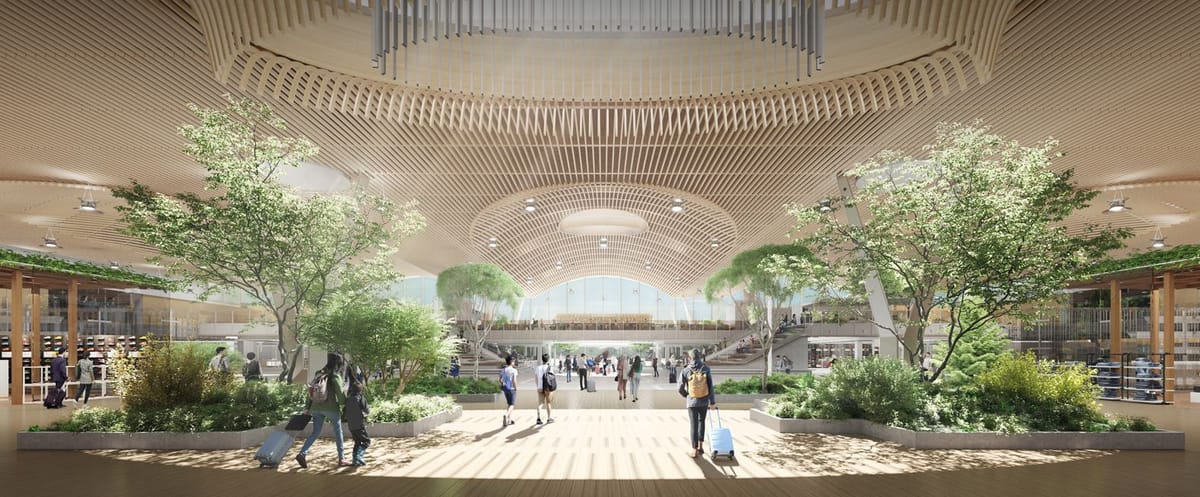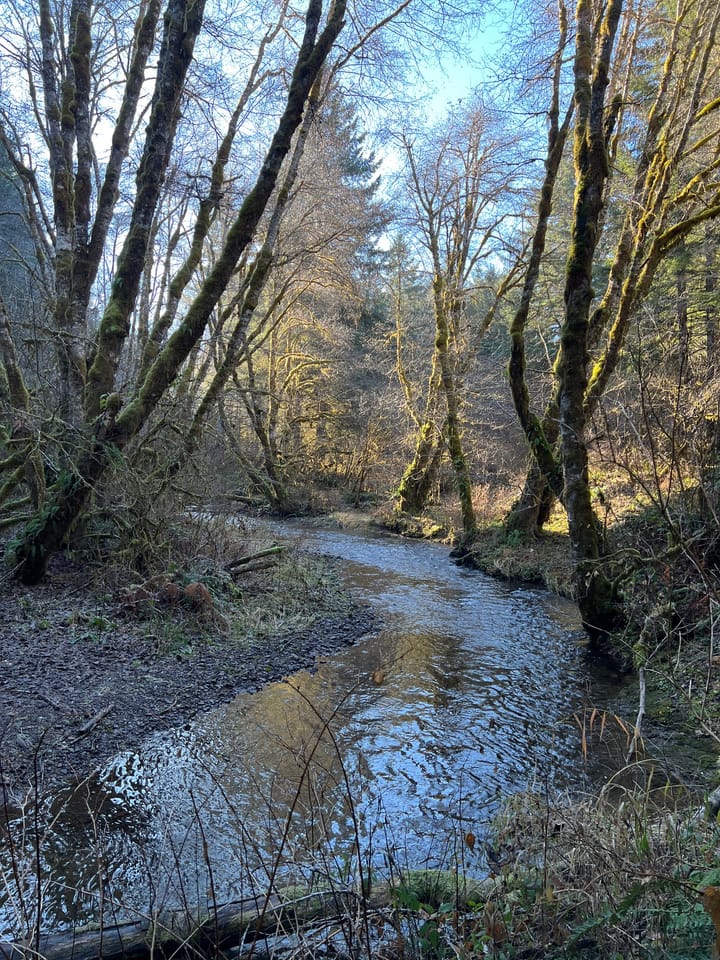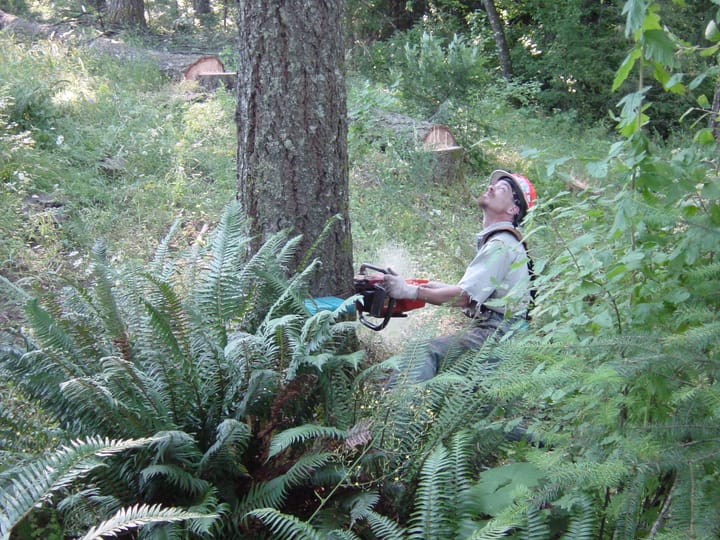Seeing PDX From the Forest

One forest steward's view of the Portland Airport rebuilding project -
There are many reasons why the current renovation and reconstruction at the Portland Airport is significant and worthy of attention. As a Coast Range forest owner and steward, viewing the project from a distance, I’m unfortunately not the right person to enumerate all of the reasons why we should take note of and learn from the project. But what I can do - and will do - is to use four stories and the invitation of a fifth to share word of how the airport project appears from the perspective of a forest and forester. My hope is that sharing these stories will highlight what I see to be an important aspect of the significance of this reshaped airport. From my forested vantage point this project about much more than lumber and a renovated airport. With hope, this project is growing into a significant chapter in the overdue maturing of a culture and our growing up as Northwesterners.
Story One – “Our” Architecture: While I can’t recall when my emerging, young self first became aware of something called architecture, I do have strong childhood memories of the feel and essence of human made spaces. Being inside these building made me - and the world - feel somehow different, in ways that went beyond being warm and dry. Though the monstrous log cabin hall of the Forestry Center, originally built for the 1905 Worlds Fair, was lost to arson in 1964, I like to believe that I recall walking in through its doors and directing my eight year old eyes up to the vastness of its soaring, wood vaulted ceiling. Similarly, childhood experiences in homes and other buildings that are considered icons of the Northwest regional style of architecture were woven into the experiences that made me who I am. Whether it was the graceful, shed-like lines, large overhangs, or the beautiful, unpainted, weathered wood, when I temporarily left the Northwest for schooling, I carried with me a feeling for an architecture that I looked on as part of making my - and our region’s - unique identity. Consciously or, more likely, subconsciously, I grew up with a feeling that these buildings, and the designs, materials and craft that made them possible, were part of our identity and culture. These entangled bonds between design, culture and identity were strengthened by my growing up with direct connections to the buildings and the people who designed and owned them. I recall Christmas dinners when I was about six hosted by family friend, Aubrey Watzek in his well know John Yeon designed home. I knew that my grandfather, through his forest and lumber connections, was a player in the growing, milling and providing of the remarkable woods that were central to these buildings. Architect John Storrs was a colorful, family friend.
Story Two - Expanding Awareness and Questioning: As whiskers came to my chin and I checked my number in the final year of the lottery deciding who would and wouldn’t be sent to fight in Vietnam, these buildings remained part of my life and regional identity. But life experiences led me to view and understand them differently. My experiences as a Eugene-based college student investigating the continuing cutting of our region’s prime, old forests led me to considering the deeper stories behind the tight grained, knot-free wood that was such a central ingredient in these buildings. While my love of this type of wood will never end, rainy days of crawling through our most majestic and complex forests as well as the stump fields left following the old forest’s clear cutting, led me to see the wood in these buildings and the people who created them in a new and different light. As my understandings and experiences grew, there was no way around my acknowledging that this wood was the result of extracting the wealth of our forests and too often exploiting the workers that the related systems depended on. Perhaps it was just the influence of life on the trailing edge of the sixties, but the question that surfaced in my consciousness persisted - and persist: “If we hope to become a culture that can successfully and respectfully endure in this place over the long haul, how can our regional identity be linked to a regionally unique style of architecture that is dependently linked to extraction of our ecological wealth and exploitation of people?”. Noted architect, John Storrs, observed in 1985 “The qualities which made Northwestern architecture singular are no longer here – they’ve evaporated”. Looking back, I realize that to some degree I reached a crossroads where circumstances forced me to choose between my allegiance to a style of architecture and building that seemed integral to our regional identity and my commitment to this land and our responsibility to create a culture that can respectfully endure in this wonderful place. Though I was jarred by running up against this choice, my decision was a simple and obvious one. I recognized that the relationship between the architecture and this place was grounded in a frontier/pioneer mentality and culture that too often did not make the wellbeing of local forests and forest-dependent human communities a priority. I saw that a positive future depends on trading in this frontier/pioneer mentality for the approaches of a settled citizen culture. Additionally, I questioned the degree to which “our” architecture was truly and fairly essential to our regional identity, or whether this was a story that some of us chose to tell ourselves. I recognized that these appealing and iconic buildings connected with and enhanced the lives of a privileged small percentage of Northwesterners while having little or no impact on the broader population. An exploration of or regionally adapted architecture should also take the long view in acknowledging that Northwesterners have been sheltered by buildings that they imagined, designed and created for at least 10,000 years – speaking of truly indigenous architecture! Regional identity and architecture is complicated.
Story Three – Learning from Markets - Like many Northwesterners, my family’s life and fortunes have been intertwined with forests and saw milling for many generations. While this caused me to grow up with some awareness of forest ecology, economics and culture, I didn’t come face to face with many of the basic truths and hard realities of the business until my life’s path led to assuming responsibilities for managing our family’s forest business in the early 2000s. There was much to learn and I enjoy the challenge. One of the many lessons was appreciating the priorities of the customers whose purchasing of our wood our business depends. Our efforts to persuade buyers that they should opt for our wood due to our success in caring for forests in ways that restore them quickly ran up against hard realities. All but a few buyers don’t care. Essentially all wood buyers decisions were shaped by simple, core beliefs and priorities. Through their actions they tell us: “we don’t know or care where the wood we use comes from - just keep it coming and keep it cheap”. At the same time that we acknowledge these realities, we don’t accept them. Idealists that we are, meaning not losing sight of the ideal, we aspired to working with customers with a wider and more forward looking and community-minded set of priorities.
Story Four – A Different Message - In 2020 our family forest business was pleased to be invited to work in partnership with customers whose actions reflect the values and priorities we’d long hoped to find. When the designers and builders of the renovated airport made contact about the possibility of using some of our wood in the project, we were excited to learn about their approach to finding and buying wood that they feel meets their needs. Instead of the too familiar “we don’t know or care where the wood comes from”, their actions reflect the belief that they care where the wood comes from and insist on knowing. Instead of the “just keep it coming and keep it cheap”, we see them committing to buying wood in ways that leave the places the wood comes from better off as a result of the relationship and transaction. As you can imagine, this is uplifting for us to hear and see. These attitudes are essential if we hope to restore and revitalize local forests and the human communities dependent on them. During our conversations with those leading the airport project, it is exciting to see them exploring ways that this one, ambitious project can and will become a stepping stone toward an ongoing succession of visionary projects.
The Next Story – And an Old Challenge - As I reflect on the progressive sequence of four stories shared above, I feel a sense of opportunity and inevitability about what story we’re invited and challenged to create next. Will we learn from the lessons, strengths and imbedded vulnerabilities of the NW regional architectural style? Will we build on the innovative and visionary approaches being tested on the airport project? Will we use opportunities like the airport remodel to demonstrate that we’re committed to making the shift from a frontier/pioneer culture to the settled citizen culture that circumstances demand? I look forward to the creation and celebration of new approaches to architecture meets the needs and potential of this place. An architecture that blend attention to function, form and aesthetics in ways that once again become powerful parts of our regional identity, while demonstrating that we can and will use wood, and other gifts from these lands, with reverence, humility and respect. In 1938 urban and regional planning visionary, Lewis Mumford, posed a provocative and fundamental question to members of Portland’s City Club: (paraphrased) “Do you have what is needed to successfully live in a place as remarkable and wonderful as the Northwest - over the long haul?”. On the long list of what’s needed to rise to Mumford’s challenge are systems of design and building that reliably reflect, honor and restore the health and wealth of our ecological and human communities. The success of responsible forestry that we so badly need hinges on choosers of wood joining with forest owners as reliable partners. Aldo Leopold foresaw this when he observed, nearly 100 years ago: “The long and the short of the matter is that forest conservation depends in part on intelligent consumption, as well as intelligent production of lumber”.
For so many reasons, we know the story that we need to imagine, create and leave for those who follow. Now we just need to take the actions that will create this positive story. From our forested hilltop, we look across the hills toward the airport and thank and encourage the shapers of the new airport for their vision, leadership and commitment. It’s about much more than a building. Should fortune make me a grandparent, I look forward to my our grandchildren’s lives being shaped and supported by buildings that are truly and authentically native to this remarkable place – honoring it in the ways that it deserves.


